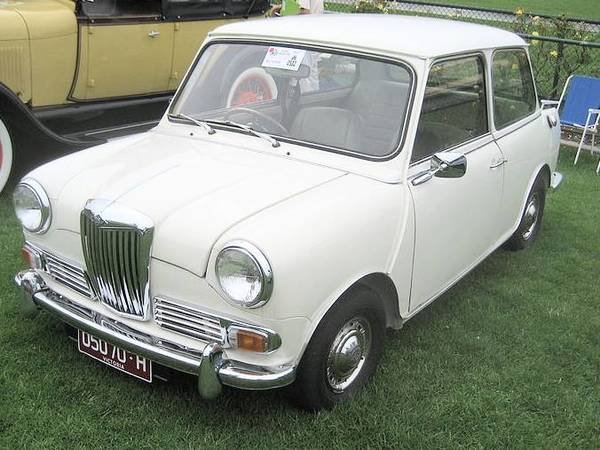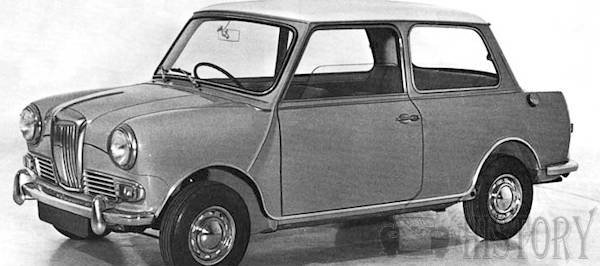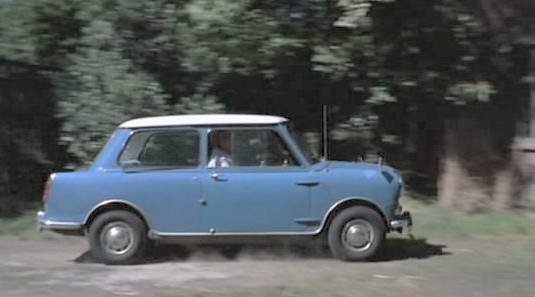Riley Elf
| 1961 to 1969 | |
|---|---|
 |
|
| Overview | |
| Also called | Austin Mini Morris Mini Wolseley Hornet |
| Production | 1961 - 1969 |
| Assembly | United Kingdom |
| Designer | Sir Alec Issigonis |
| Body and chassis | |
| Body style | 2-door saloon |
| Powertrain | |
| Engine | 850 cc (0.9 l) I4 997 cc (1.0 l) I4 998 cc (1.0 l) I4 1,071 cc (1.1 l) I4 1,275 cc (1.3 l) I4 |
Built as more luxurious versions of the Mini, both the Wolseley Hornet and the Riley Elf had longer, slightly finned rear wings and larger boots that gave the cars a more traditional three-box design. Wheelbase of the Elf and Hornet remained at 2.036 m (6.68 ft), whereas the overall length was increased to 3.27 m (10.7 ft). This resulted in a dry weight of 638 kg (1,407 lb)/642.3 kg (1,416 lb) (rubber/hydrolastic suspension) for the Elf and 618 kg (1,362 lb)/636.4 kg (1,403 lb) for the Hornet respectively.The distribution of weight to the front axle, 40 % and rear axle 60 %.
Front-end treatment, which incorporated each marque's traditional upright grille design (the Hornet's grille with a lit "Wolseley" badge), also contributed to a less utilitarian appearance. The cars had larger-diameter chrome hubcaps than the Austin and Morris Minis, and additional chrome accents, bumper overriders and wood-veneer dashboards. The Riley was the more expensive of the two cars. The name "Wolseley Hornet" was first used on a 1930s sports car, while the name "Elf" recalled the Riley Sprite and Imp sports cars, also of the 1930s. The full-width dashboard was a differentiator between the Elf and Hornet. This dashboard was the idea of Christopher Milner the Sales Manager for Riley. Both the Riley Elf's and Wolseley Hornet's bodies were built at Fisher & Ludlow under their "Fisholow" brandname. Plates in the engine compartment on the right side fitch plate bear evidence of this speciality. Very early Mark I versions of both cars (e.g. press photo of 445MWL) had no overriders on the bumpers and a single piece front wing (A-panel and wing in one piece, no outside seam below scuttle panel) that was soon given up again, allegedly due to cost.fuel tank capacity: 5.50 imp gat, 6.60 US gal, 25 1.
The Elf's and Hornet's special bumper overriders first appeared in 1962. Early production Mark Is also had a combination of leather and cloth seats (Elf R-A2S1-101 to FR2333, Hornet W-A2S1-101 to FW2105) whereas all later models had full leather seats. Mark I models were equipped with single leading shoe brakes on the front.
Both the Elf and the Hornet went through three versions. Initially, they used the 848 cc (51.7 cu in) 34 bhp (25 kW) engine (engine type 8WR) with a single HS2 carburettor, changing to a single HS2 carburettor 38 bhp (28 kW).
PERFORMANCE:848 cc
- Engine Capacity 51.86 cu in, 848 cu cm;
- Fuel Consumption 42.1 m imp gal, 35.1 m US gal, 6.7 1 x 100 km
- Max Speed 64 mph, 103 km h
- max power (SAE): 37 hp at 5500 rpm
- max torque (SAE): 44 1b ft, 6.1 kgm at 2900 rpm
- max number of engine rpm: 5500
version of the Cooper's 998 cc (60.9 cu in) power unit (engine type 9WR) in the Mark II in 1963. This increased the car's top speed from 71 to 77 mph (114 to 124 km/h) . Therefore, Mark II cars also came with increased braking power in the form of front drum brakes with twin leading shoes to cope with the increased power output.
Both Mark I and Mark II featured four-speed, gearboxes (three synchromesh gears) with rod gear change, a.k.a. "magic wand" type. Automatic gearboxes became available on the Mark II in 1965 as an option. The Mark III facelift of 1966 brought not only wind-up windows and fresh-air facia vents, but disc brakes replaced front drum brakes, too. Concealed door hinges were introduced two years before these were seen on the mainstream Mini. The gear selecting mechanism was updated to the rod type, as seen on all later Mini type cars. Automatic gearboxes were available to the Mark III in 1967 again. Full-four synchromesh gearing was eventually introduced during 1968. 30,912 Riley Elfs and 28,455 Wolseley Hornets were built. Production ceased in late 1969 when British Leyland discontinued the Riley and Wolseley brand names.

Later Mark III Elf
Vehicle Identification – Serial Number Prefix Letter Code:
- First prefix letter – name: R-Riley, W-Wolseley
- Second prefix letter – engine type: A
- Third prefix letter – body type: 2S – 2-door Saloon
- Fourth prefix – series of model: 1 – 1st series, 2 – 2nd series, 3 – 3rd series
- Fifth prefix (used to denote cars different to standard right hand drive): L – left hand drive
Code example: R-A2S1-154321 (Riley, A type engine, 2 door saloon, 1st series, serial number "154321")
In Film and Television
Riley Elf MkIII in Inspector George Gently TV Series

Riley Elf MkI in The House That Dripped Blood, Movie from 1971.

Technical
-
Riley Elf Technical details and specifications (1961-1969)
848cc - 998 cc A Series EnginesNo. of cylinders 4/OHV
Capacity 848 cc and 998 cc
Firing order 1-3-4-2
Compression ratio 8.3:1
Suitable for unleaded petrol No
Fuel system 848cc Make SU Type HS2 Carb-VV
Fuel system 998cc Make SU Type HS2/HS4 Carb-VV
Ignition coil Make Lucas Type LA12
Distributor Make Lucas No. 25D4/45D4
Distributor Contact breaker gap 0.4mm
Distributor Dwell angle 848cc 57-63° 46-56 (%) 998cc 57-63° (63-70%)
Fuel pump pressure 0.17-0.21 bar
Starter motor Make Lucas Type M35G/M35J
Maximum cranking amps 97-119 A
Voltage regulator Make Lucas RB 106/2
Regulated voltage 13.9-14.3V
cylinder block: cast iron
cylinder head: cast iron
crankshaft bearings: 3
valves: 2 per cylinder, overhead, in line, with push-rods
Fuel Consumption: 46 m imp gal, 38.5 m Us gal, 6.1 | x 100 kmTRANSMISSION:
driving wheels: front
clutch: single dry plate, hydraulic drive
gear box: mechanical, in unit with engine
gears: 4 + reverse: synchro- Ill, IV; gear box ratios: (I) 3.627, (II) 2,172, (III) 1.412, (IV) mesh gears: II, (Rev) 3.627
final drive: spiral bevel; ratio: 3.765 : 1.CHASSIS:
type integral; front suspension: independent, wishbones, rubber springs, telescopic dampers
rear suspension: independent, swinging longitudinal arms, rubber springs, telescopic dampers.STEERING:
rack-and-pinion
turns of steering wheel lock to lock: 2.33.BRAKES:
drum; braking surface: total 67.42 sq in, 435 sq cm.ELECTRICAL EQUIPMENT:
voltage: 12 V
battery: 34 Ah
ignition distributor: LucasDIMENSIONS AND WEIGHT:
wheel base: 80.16 in, 2036 mm
front track: 47.76 in, 1213 mm
rear track: 45.87 in, 1165 mm
overall length: 130.31 in. 3310 mm
overall width: 55.50 in, 1410 mm
overall height: 53.00 in. 1346 mm
ground clearance: 6.30 in, 160 mm
dry weight: 1408 1b, 639 kg
© Motor car History
Service
-
Riley Elf Practical Instructions and Service Guide (1961-1969)
848cc - 998 cc A Series Engines
Spark plugs Original equipment Champion Type RN9YCC
Spark plugs Electrode gap 0.8mm
Spark plugs Tighten 25-35 Nm
Valve clearance -INLET 0.30mm check cold
Valve clearance -EXHAUST 0.30mm check cold
Drive belt size - alternator 9,5x825 mm
timing: (inlet) opens 5° before tdc and closes 45° after bdc, (exhaust) opens 40° before bdc and closes 10° after tdc
Drive belt tension - alternator 25mm
engine oil change, 4.2 imp qt, 4.8 US qt, 4.5 1, SAE 1OW-20 (winter) 20W-30 (summer) change every 3000 miles, 4800 km
Cooling system 3.5 litres© Motor car History
